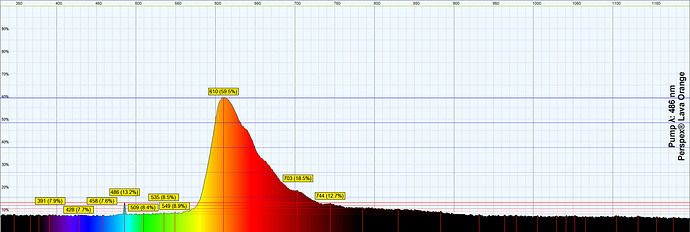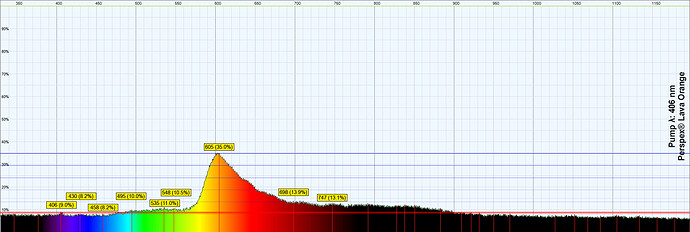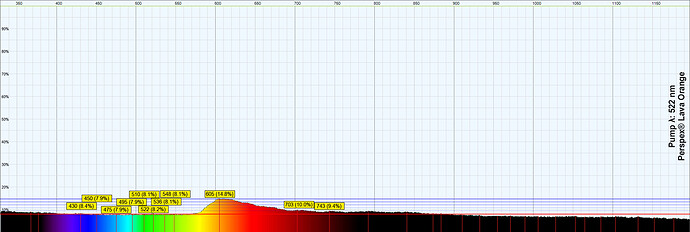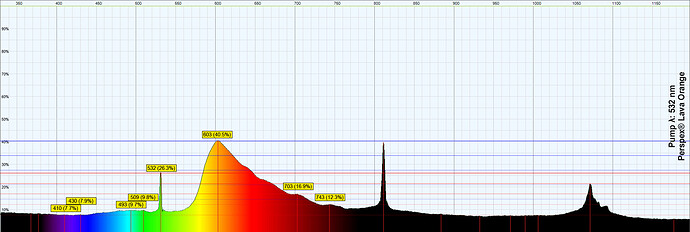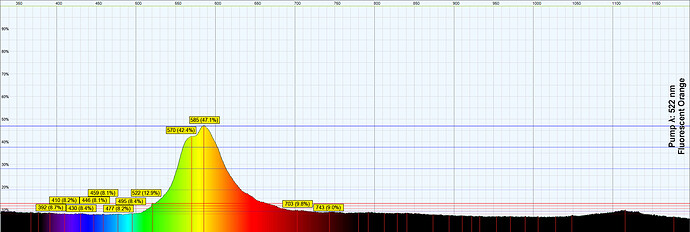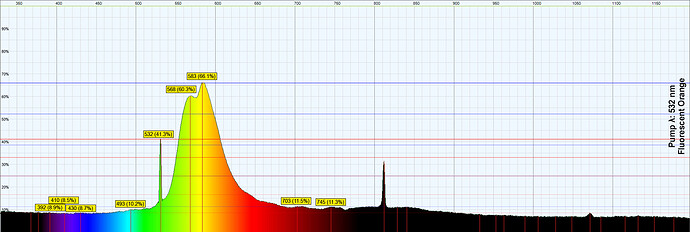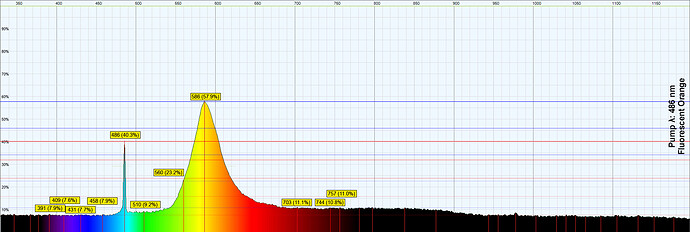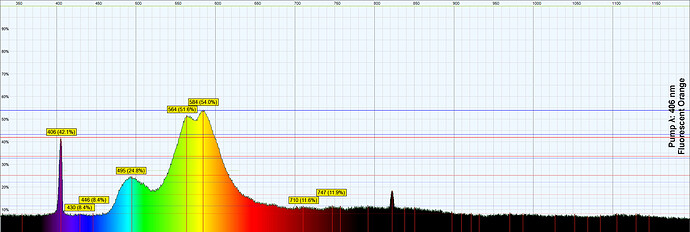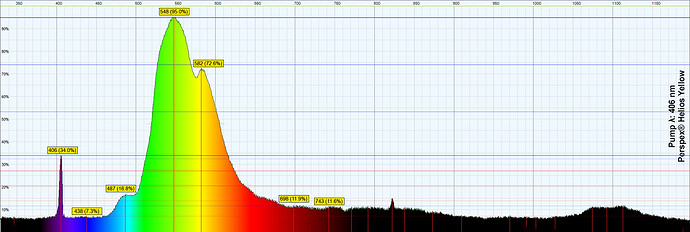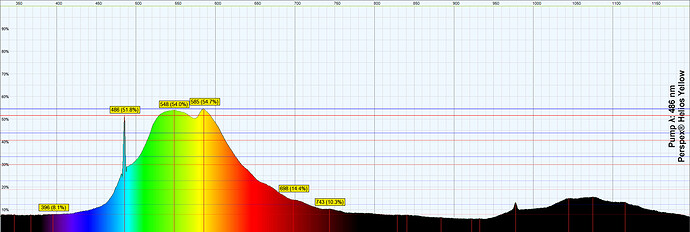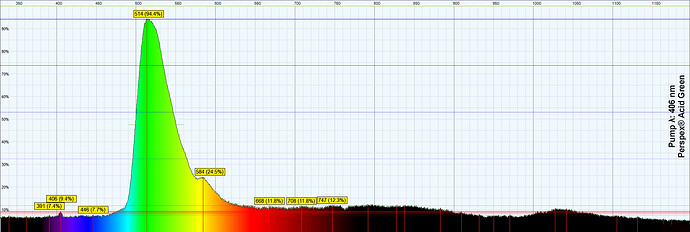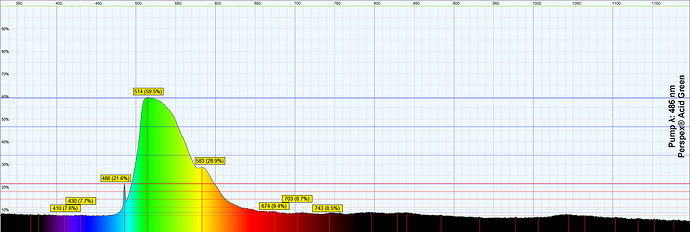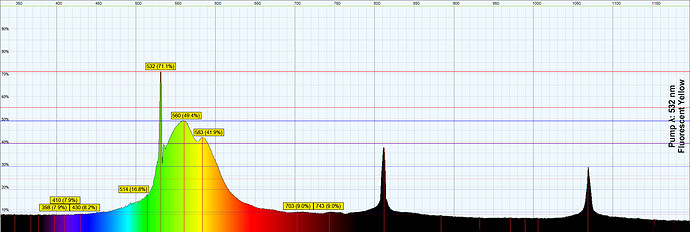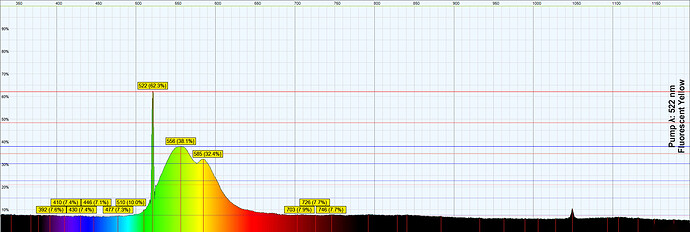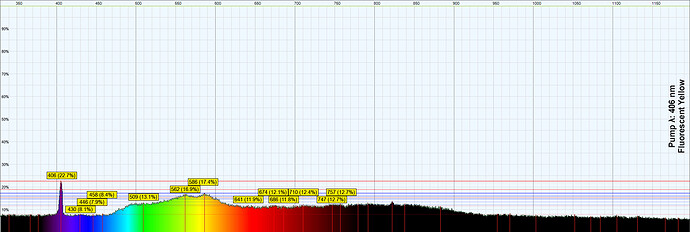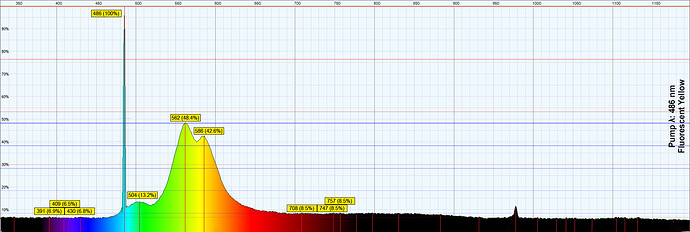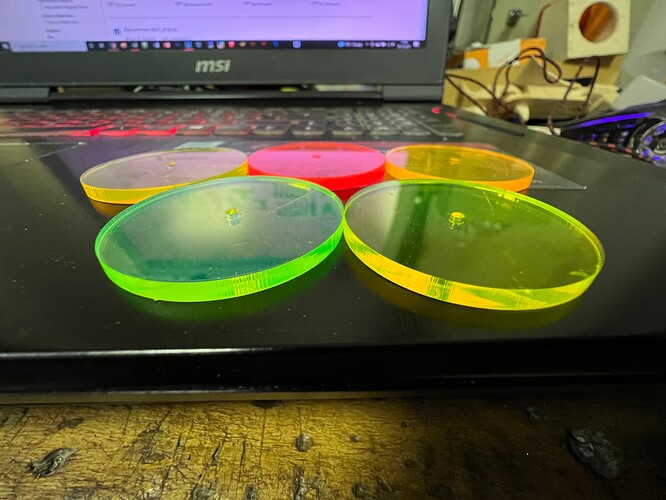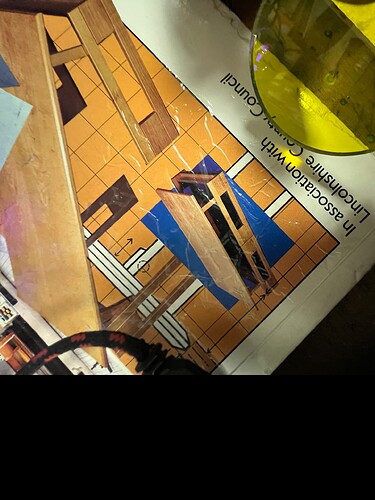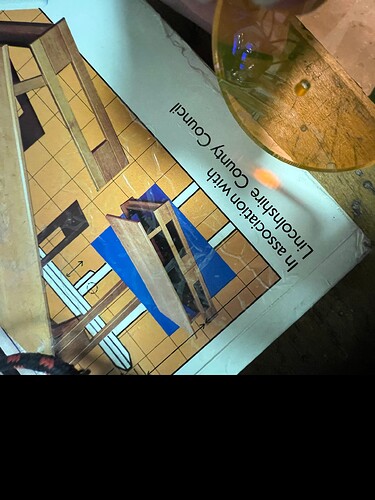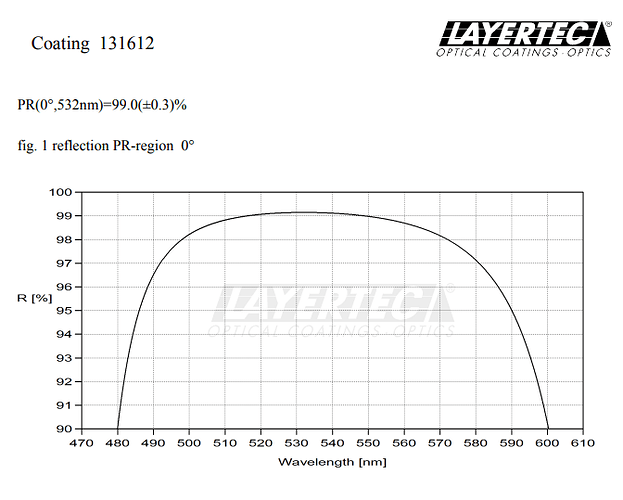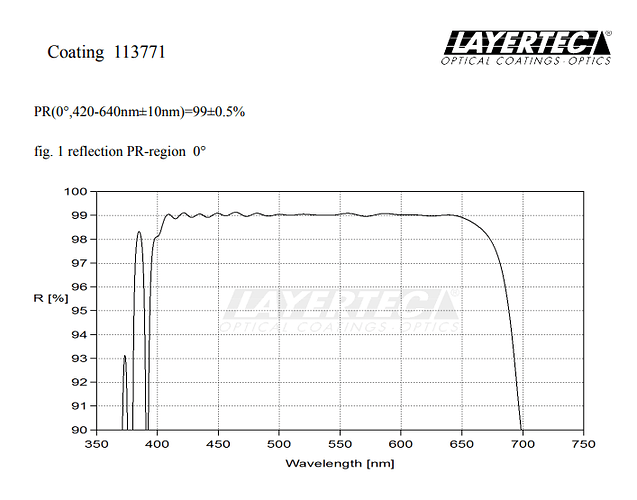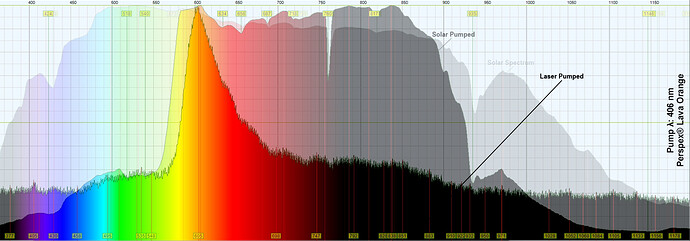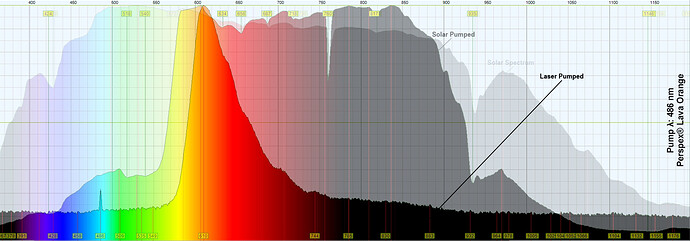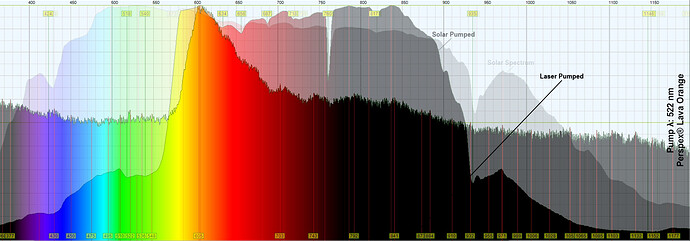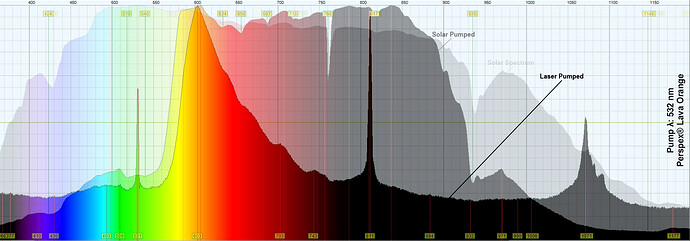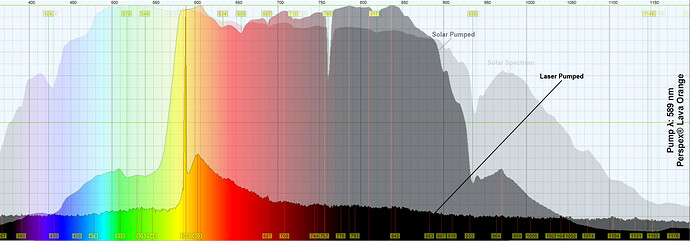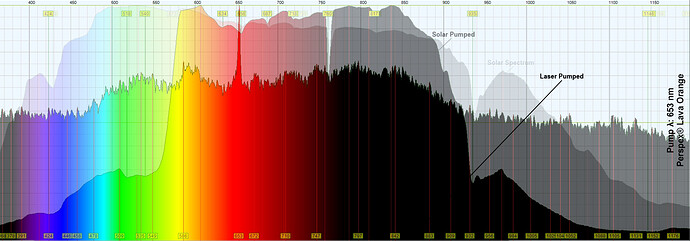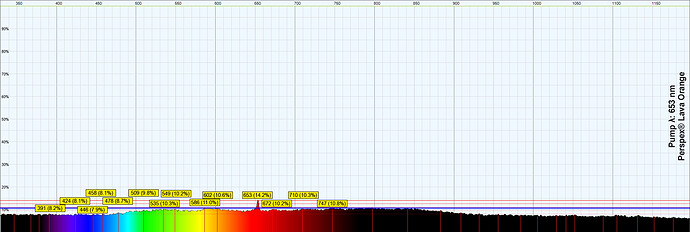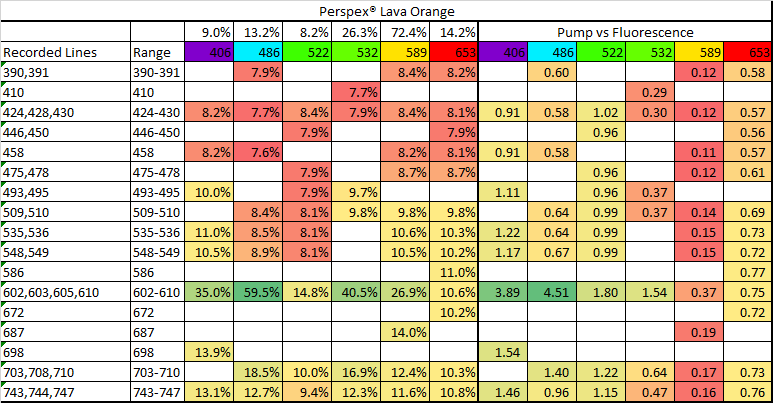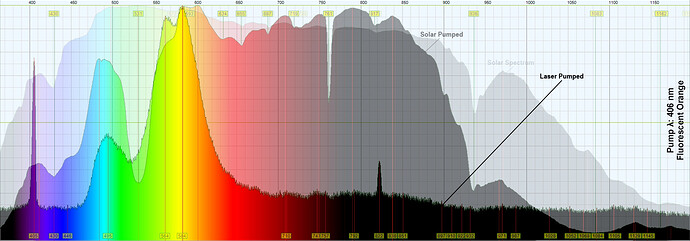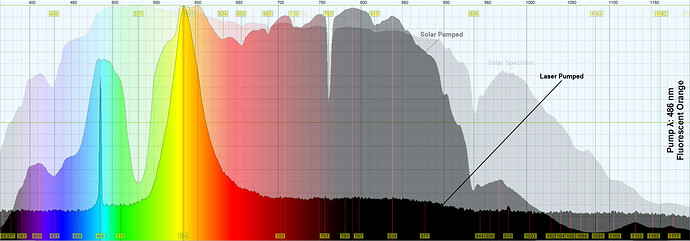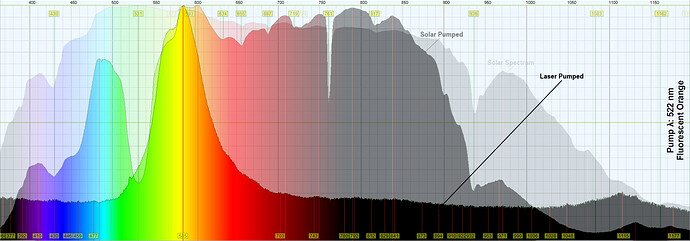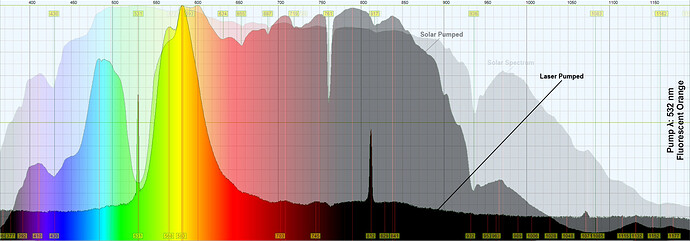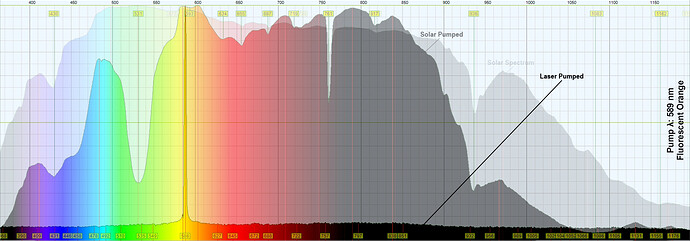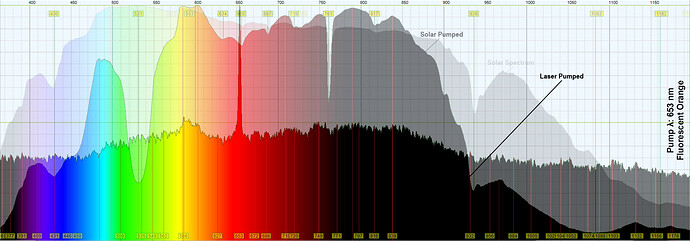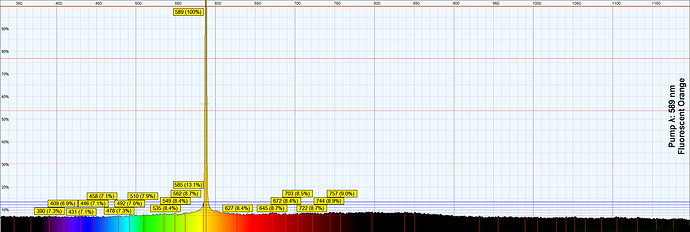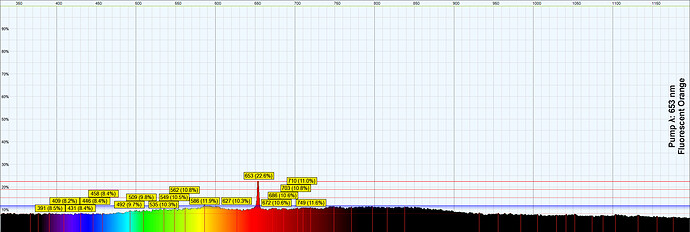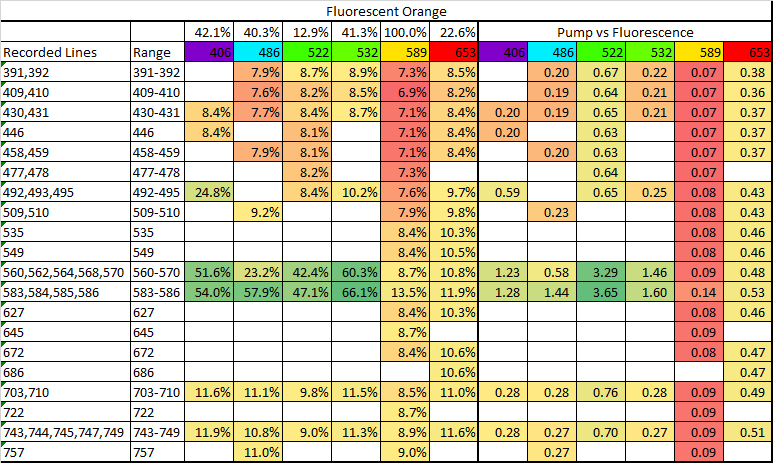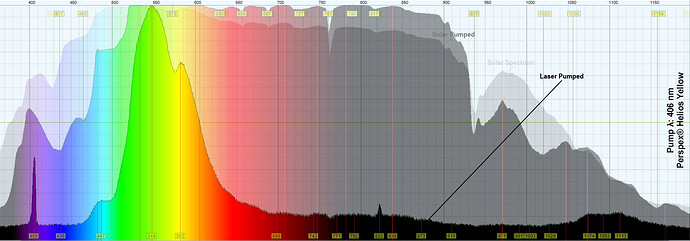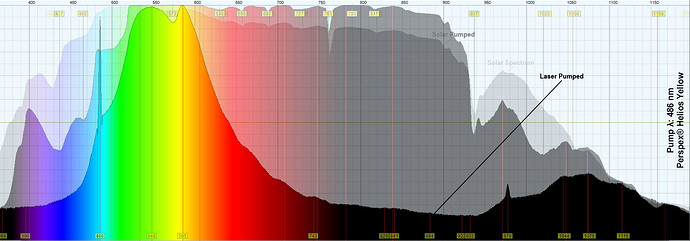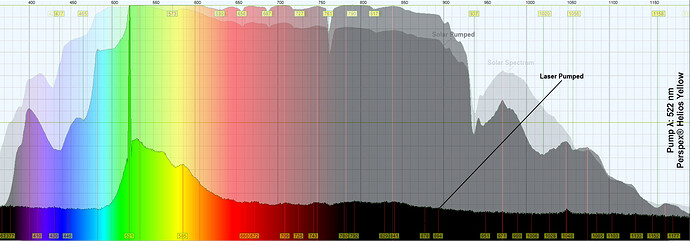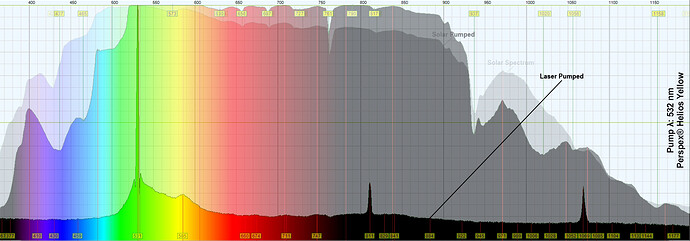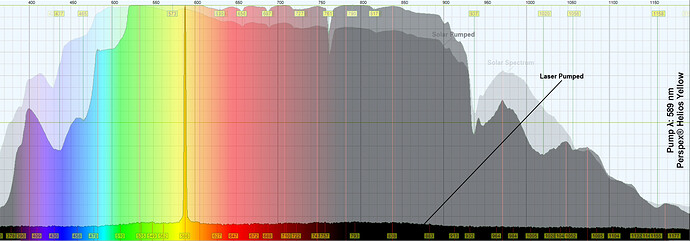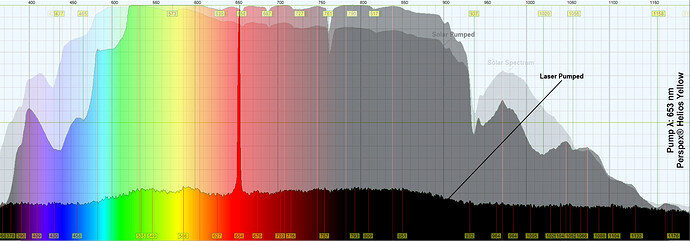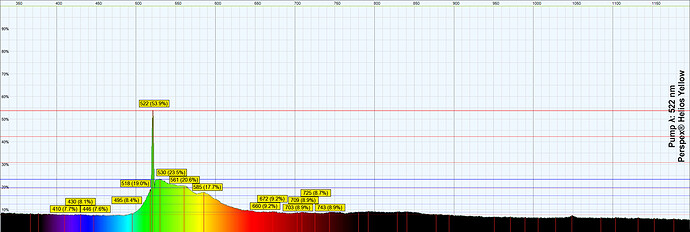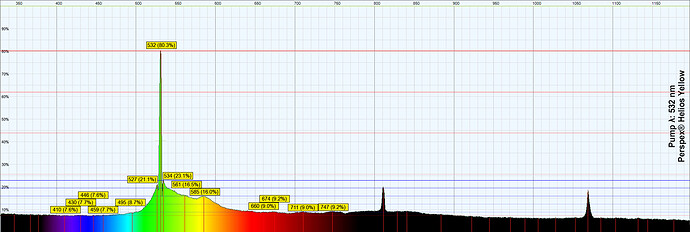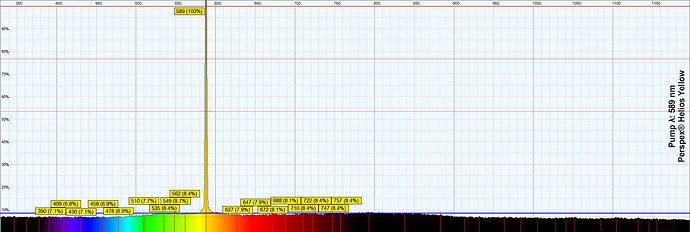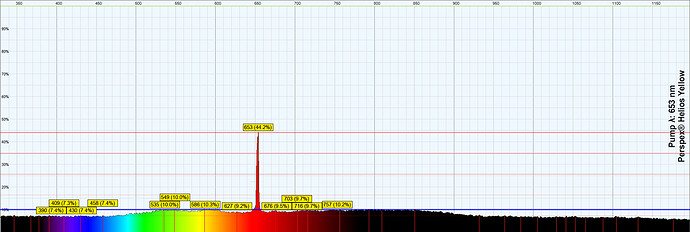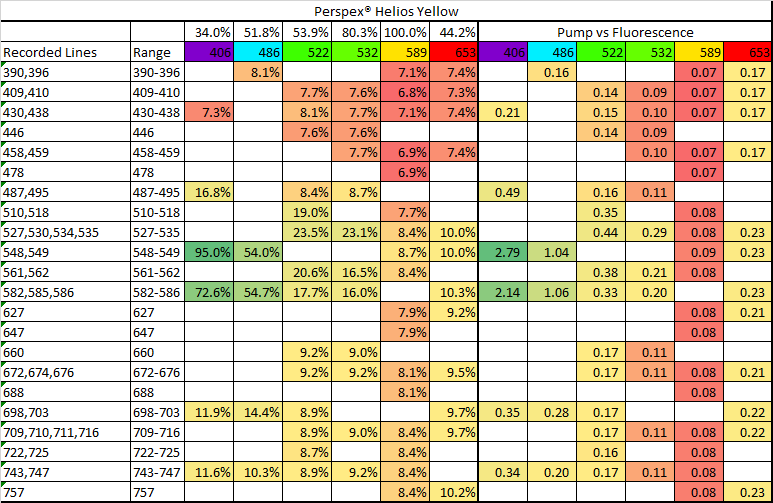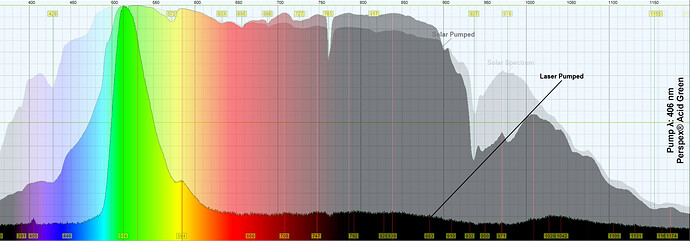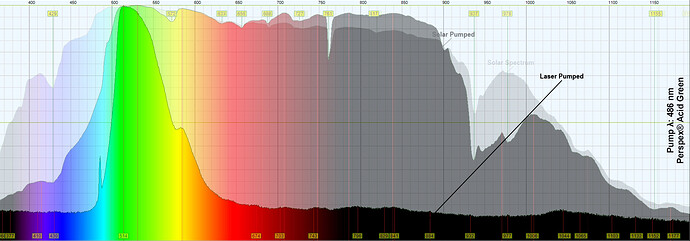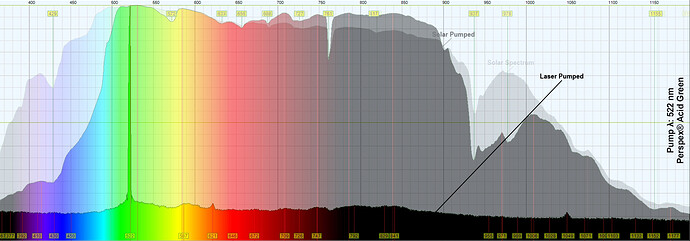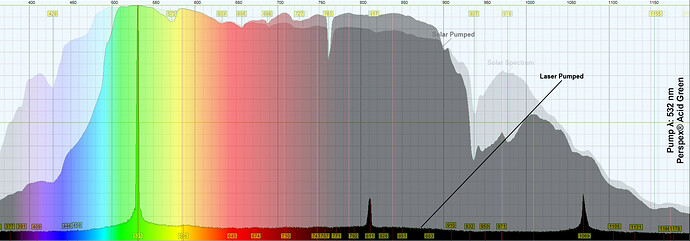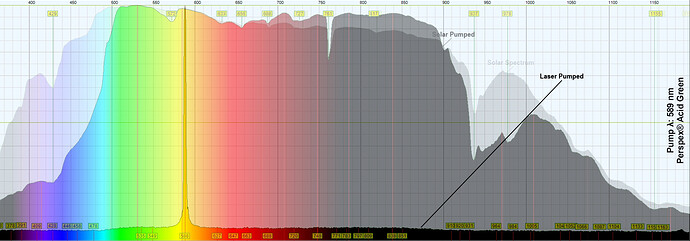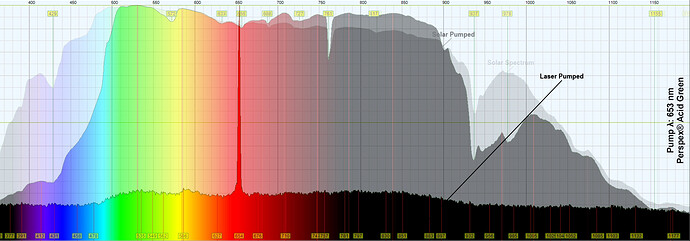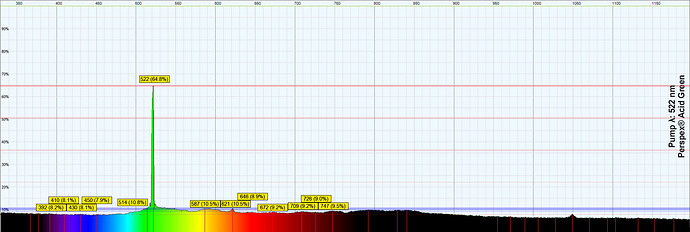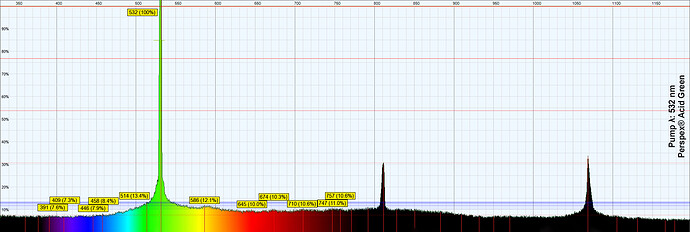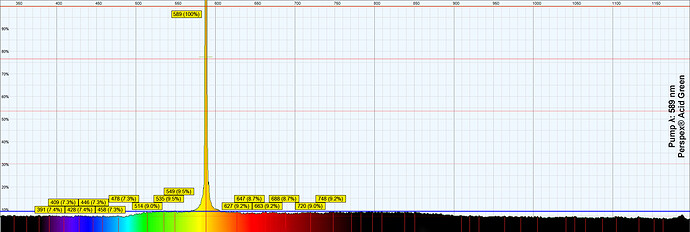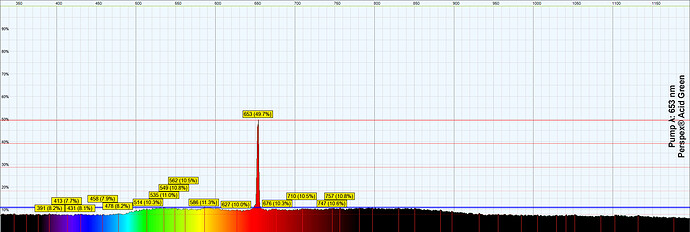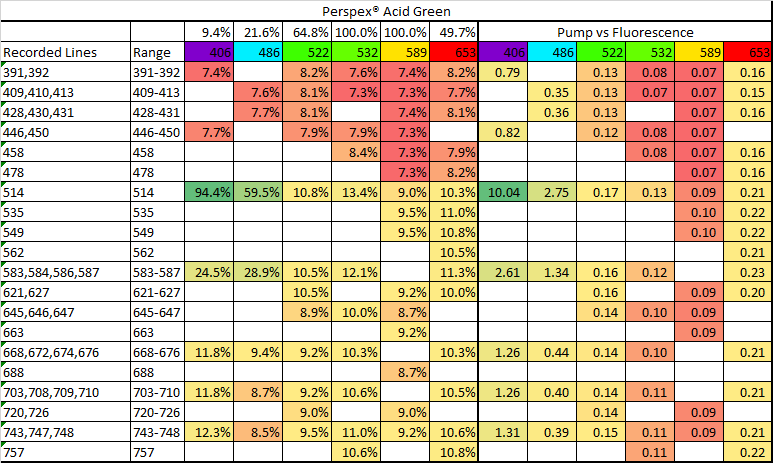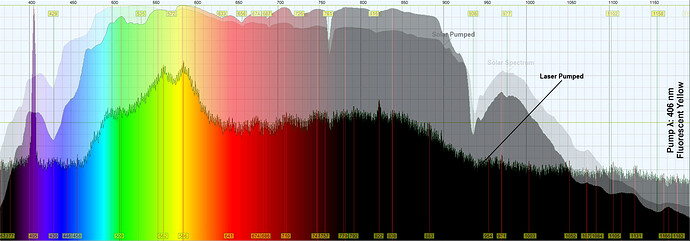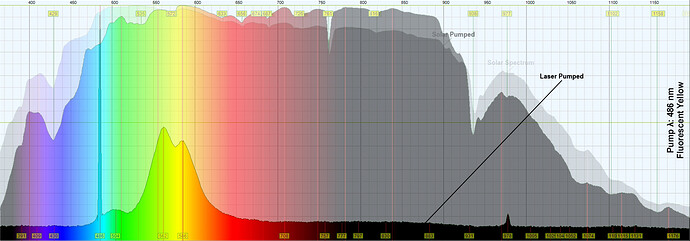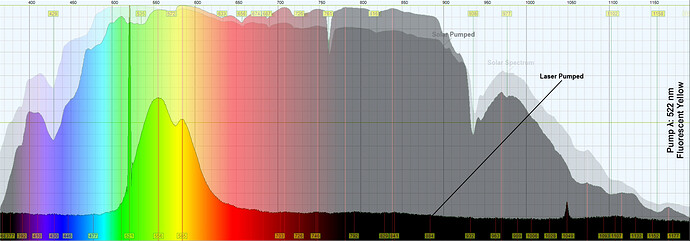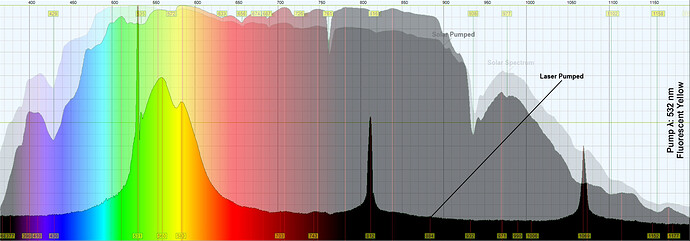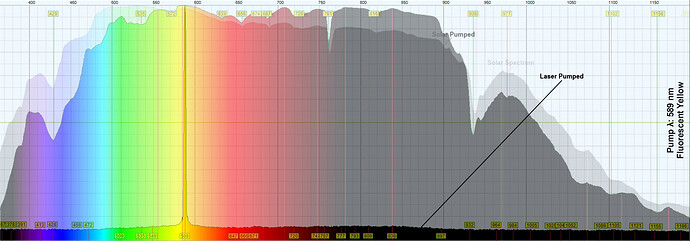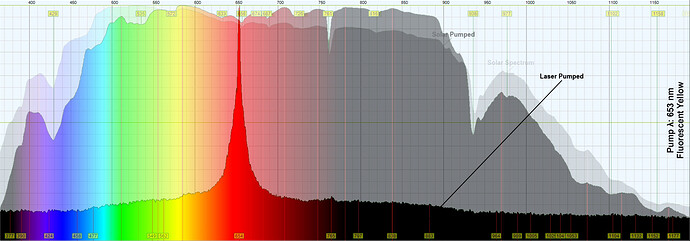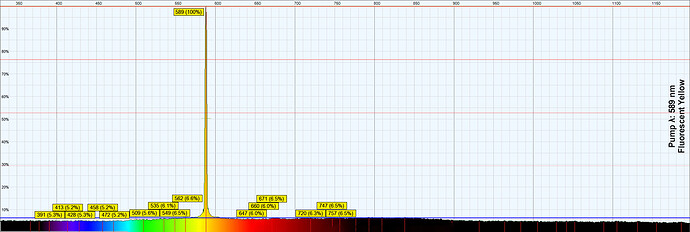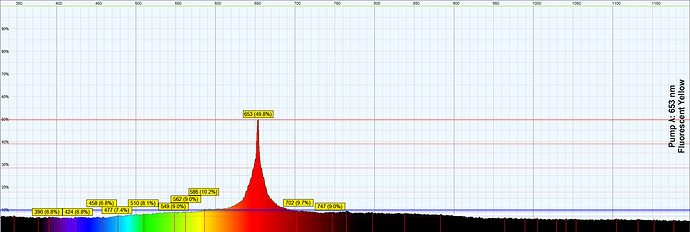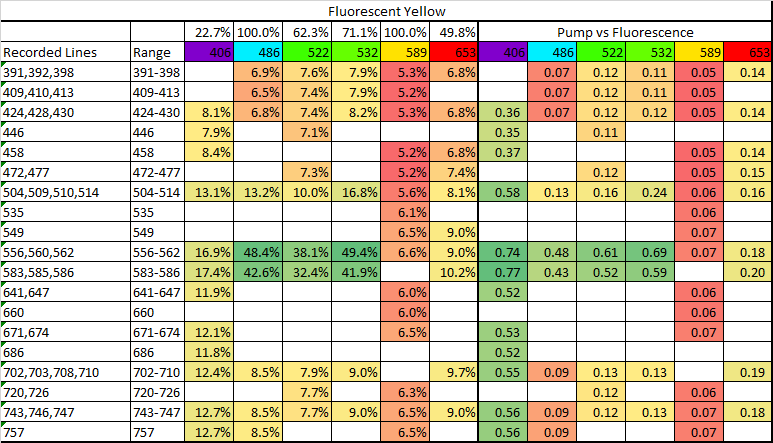I found this highly interesting and would love to find the time to experiment on this.
Solid State Dye Laser (PMMA):
PMMA Sample Analysis:
Perspex® Lava Orange:
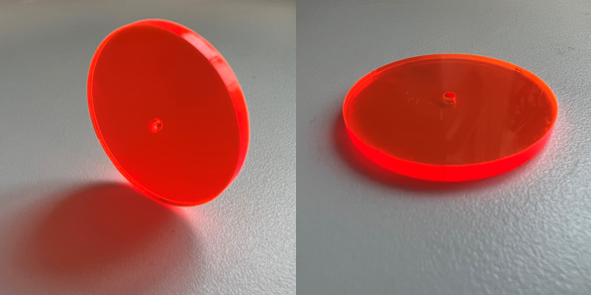
Best peak lines: 602-610
Best pump source: 486,406,522,532
Median Lasing Tuning Range (>50% Pump):
406: 588 [24.0%] - 605 [35.0%] - 632 [24.0%]
486: 594 [37.4%] - 610 [59.5%] - 650 [37.4%]
522: 591 [12.1%] - 605 [14.5%] - 649 [12.1%]
532: 585 [27.4%] - 603 [40.5%] - 644 [27.4%]
589: n/a
653: n/a




Jump to Perspex® Lava Orange Full Spectrum Analysis
Fluorescent Orange:
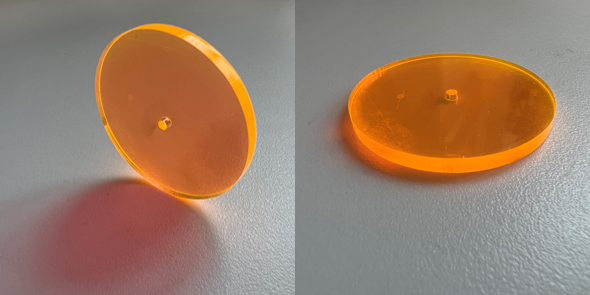
Best peak lines: 583-586,560-570
Best pump source: 522,532,486,406
Median Lasing Tuning Range (>50% Pump):
406: 547 [32.7%] - 564 [51.6%] - 575 [49.2%] - 584 [54.0%] - 607 [32.7%]
486: 569 [34.2%] - 586 [57.9%] - 608 [34.2%]
522: 552 [28.1%] - 570 [42.4%] - 574 [42.3%] - 585 [47.1%] - 614 [28.1%]
532: 553 [38.5%] - 568 [60.3%] - 576 [59.4%] - 583 [66.1%] - 608 [38.5%]
589: n/a
653: n/a




Jump to Fluorescent Orange Full Spectrum Analysis
Perspex® Helios Yellow:
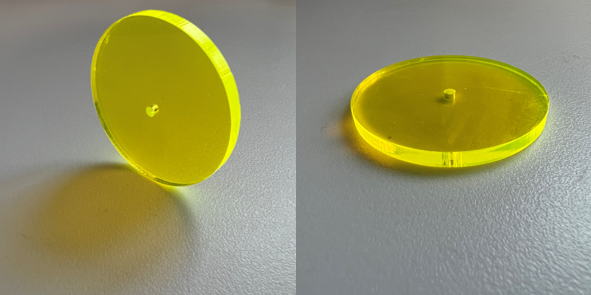
Best peak lines: 548-549,582-586
Best pump source: 406,486
Median Lasing Tuning Range (>50% Pump):
406: 521 [53.2%] - 548 [95.0%] - 575 [68.2%] - 582 [72.6%] - 601 [53.2%]
486: 504 [33.4%] - 548 [54.0%] - 573 [50.2%] - 585 [54.7%] - 626 [33.4%]
522: n/a
532: n/a
589: n/a
653: n/a


Jump to Perspex® Helios Yellow Full Spectrum Analysis
Perspex® Acid Green:
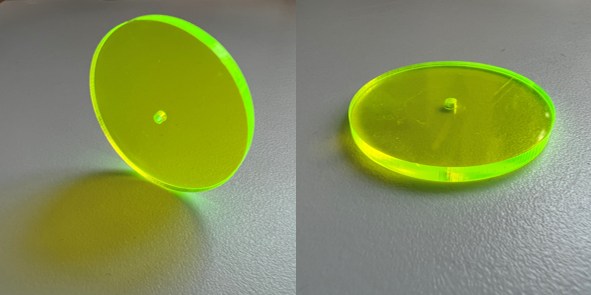
Best peak lines: 514,583-587
Best pump source: 406,486
Median Lasing Tuning Range (>50% Pump):
406: 500 [53.1%] - 514 [94.4%] - 547 [53.1%]
486: 501 [34.0%] - 514 [59.5%] - 567 [34.0%]
522: n/a
532: n/a
589: n/a
653: n/a


Jump to Perspex® Acid Green Full Spectrum Analysis
Fluorescent Yellow:
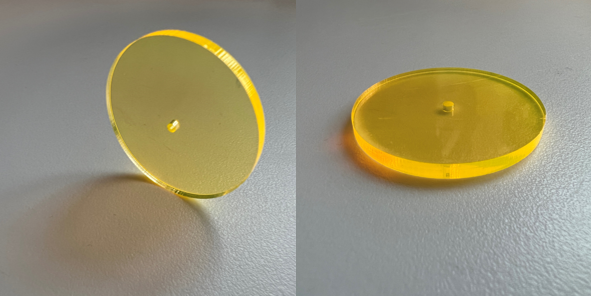
Best peak lines: 556-562,583-586
Best pump source: 532,522,406,486
Median Lasing Tuning Range (>50% Pump):
406: n/a
486: n/a
522: n/a
532: n/a
589: n/a
653: n/a




Jump to Fluorescent Yellow Full Spectrum Analysis
2 Likes
Cut some discs of live edge acrylic. They must have fluorescent dye already inside the material.
Might get my spectrometer on them and see what absorption and emission spectrum they have. Interestingly. Shining my phone light through two of the samples edges gives a nice vivid yellow, and orange/yellow output. Another has a beautiful red output like my ruby crystal.
1 Like
I’d love to see the wavelength these put out and what they do with coherent light pumping them.
1 Like
I doubt I’ll get any of them lasing without investing in one of these.
https://www.layertec.de/en/shop/datasheet-105737/
That output coupler will be perfect for the broadband operation that these discs require. You need <5%T for the output coupler to be efficient.
However I should at least be able to work out whether a laser in my collection is suitable for pumping.
4.25W of 532nm is plenty of pump power if that works. However I have 7W+ of 445nm too if needed.
The reason why I’ve cut them as discs is so they can be spun on a motor. That way the pmma won’t suffer immediate bleaching and burns from the pump source.
1 Like
Find out if you want it, if you do, I will contribute to the cause and buy one for you.
Thanks for the offer Chris. I will be post spectrums of the samples. And then we can look into whether this is actually viable.
I doubt any of the samples will have the same dye they used in their setup. But imagine if one of them did? There can’t be that many ways of making PMMA fluoresce so a genuine high quality dye must of been used in them. It is just unknown what dyes are in each. But those dyes may lase with enough pump energy and within a resonating cavity? That’s my thinking.
The challenge for me will be how I go about pumping it. The edges of the PMMA glow, but the faces don’t. But any time you cut it that edge glows, so dye must be evenly distributed within the material. Just need to activate that dye.
1 Like
OK, let’s see what you find 
1 Like
Found myself a piece of blue and green translucent acrylic to make a blue light filter. They glow nicely under blue light and green light. They did not react under red light. Classic of fluorescence to be fair. However fluorescence does not usually react strongly to green however they all glowed under it.
1 Like
Ah, should read carefully. That other coupler was for nanosecond operations.
The equivalent for CW is this.
https://www.layertec.de/en/shop/datasheet-133662/
~99%T is high, but it will definite resonate whatever photons are emitted.
What is nice is that this OC can be used anywhere in the visible spectrum.
1 Like
Price isn’t too bad, I’ve seen a LOT higher prices for optics like this.
1 Like
True. It is a multipurpose optic. Could reuse it in many visible applications that need high resonance gain. Cool because most cavities that need it would be difficult to lase or irregular mediums.
1 Like
I’ve been busy with the spectrometer today. Captured 57 spectrums in total. I now have to sort through them and make sense of all of them. However I was expecting disappointment as life never goes smoothly. But I found a very exciting sample of PMMA. Absorbs 532nm beautifully as well as outputting strongly in the yellow part of the spectrum. Peak ~585nm. I’ll collate my findings and graphs with you asap. Got a lot of organise and analyse.
@Laser_Project First spectrums coming up.
Very interesting spectrums on this sample. However I have another unknown branded sample which fascinates me more. I’ll share that later.
The laser pumped spectrum is overlayed on top of the solar spectrums. That way you can make sense of the materials initial spectrum.
Perspex® Lava Orange

The thing to take note of here is even out of range of typical fluorescence you can still see weak peaks. More than just fluorescence is occurring.
Relative Intensity Spectrums
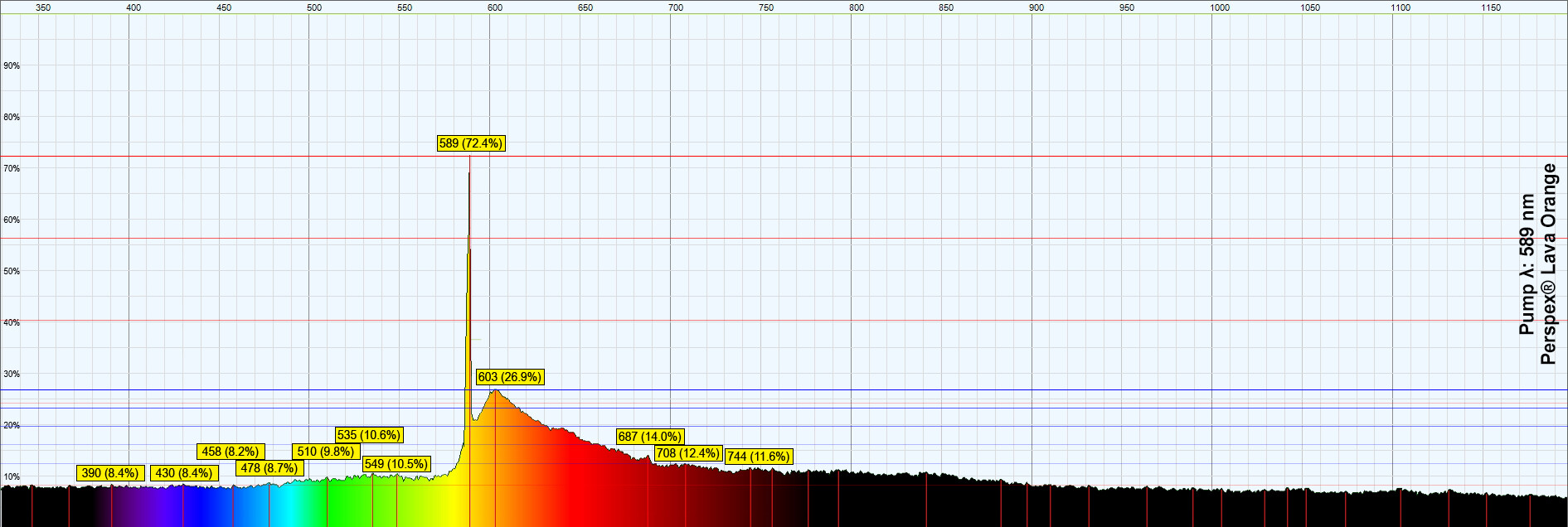
Conclusion:
Findings show Perspex® Lava Orange is best pumped by 486nm. 486nm created the highest peak (59.5%) and the highest yield (451%) overall at 610nm output. Regardless of pump wavelength Perspex® Lava Orange outputs strongly between 602-610nm. The next best pump wavelength is 406nm with a peak (35%) at 605nm, and a yield of 389%. Both 406nm and 486nm are power limited within the hobby however. The best available high power pump source for this PMMA is 532nm.
Despite the lower yield of 154%, inputting more power allows strong obvious peaks. 532nm produced the second highest peak in my tests (40.5%). This proves 532nm is very effective still at exciting the fluorescent lines. Pumping with 532nm would be the equivalent of pumping with brute force. Alternatively, it may be possible to pump with a high power argon using the 488nm line. 522nm beats 532nm in yield, but it might of needed greater intensity in the test to make full use of it. The peak was rather weak despite having better efficiency. Emission can still be achieved using 589nm and 653nm. The yield however is below 100%. Lasing may be possible but would be inefficient and require a high lasing threshold. Strangely more lines are present however weak when pumped with longer wavelengths.
1 Like
Very nice work, you do such a good job on everything you do. Good stuff!
1 Like
Thanks Chris. Got 4 more samples to add for now. Might also dig out my old wl arctic so I can get myself some low power 445. You can change modes on that.
Also I’ve noticed that Perspex has two other samples on offer that could be of interest. A red and blue fluorescent sheet.
1 Like
Fluorescent Orange

I feel like this sample has the most promise of lasing under a intense green pump. Followed closely by the previous Lava Orange sample. Notice how there is absorption at the green part of the spectrum. Interestingly absorption appears to be substantial at 522nm however even with the more intense 532nm input, the intensity of the output is significant. This plastic sample strongly emits yellow and lime-yellow photons. The lava orange sample will be best for yellow/orange output. A unexpected find however also occurred. Look closely at the spectrum pumped by 589nm. At first I thought it was insignificant. Not apparent emission visible. However there is a like output at around 584-5nm like the other spectrums. But it appears that pmma sample is a resonant almost with the 589nm input. A candidate for laser cooling?
Edit: Corrected Spectro image alignment
Relative Intensity Spectrums
Conclusion:
Fluorescent Orange has two dominant portions of the spectrum including 560-570nm and 583-586nm. This sample is best pumped by green wavelengths. 522nm being the best overall, whilst 532nm providing high peaks under intense pumping.
486nm seems to only produce strong 583-586nm lines as the 560-570nm peaks are eliminated. This sample cannot be expected to lase under 589nm or 653nm. The 589nm line is so strong that it appears Fluorescent Orange only absorbs and reemits. Barely any 585nm peak is present on the graph. As with the Lava Orange PMMA, longer wavelengths appear to produce more weak lines than can be achieved with shorter wavelengths. 406nm also performed well and may under intense pumping produce cyan (492-495) despite the lower than 100% yield.
1 Like
Perspex® Helios Yellow

Lack of peaks under longer wavelengths suggests this sample relies heavily on fluorescence alone.
It may be possible to get laser action out of it by pumping with a BDR-209.
I have noticed a pattern emerging across the samples however. I am convinced that they all must have the same dye or the same two dyes present in differing concentrations. The green and yellow/orange bands are pretty consistent just vary in intensity depending on what part of the spectrum they favour.
Relative Intensity Spectrums
Conclusion:
Helios Yellow has two strong peaks at 548-549nm and 582-586nm. This sample is biased towards shorter wavelengths with 406nm being optimal and 486nm following. Another weak band can be produced at 527-535nm if using 522/532nm. However pumping at these wavelengths is unlikely to be sufficient enough to reach lasing threshold. 589nm and 653nm produced very weak results overall. Not unsurprising when this sample favours more energetic florescence and therefore higher energy photons in shorter end of the spectrum. This could be a good alternative sample to produce yellow light, however its main emphasis especially when pumped by 406nm is lime-green emission.
Perspex® Acid Green

Very nice green output from this sample. Significant photon emission under 406nm.
Relative Intensity Spectrums
Conclusion:
Perspex® Acid Green is a very strong emitter in the green spectrum especially at its peak at 514nm. There is also another band present at 583-586nm. Due to the higher energy fluorescence, this sample can only be viably pumped by short wavelengths. Efficiency quickly drops when pumping with >500nm wavelengths. 406nm is the best pump for this sample by far. The brightest peak and highest yield out of any of the samples was achieved by pumping with 406nm. More lines are produced with longer wavelengths, but are unlikely to be of much use. Overall this is a very good sample for green emission and can be pumped using 406nm or 486nm.
Fluorescent Yellow

Saved the weirdest sample for last. Not a particularly exciting one. However it doesn’t follow suit with typical fluorescence. Also this sample is more translucent than the others. I started to doubt if I picked this one up by mistake. However the edges do glow under the right angles.
Something to note is the pmma didn’t show much signs of non-fluorescent emission when compared to longer wavelengths. You can see that the green and yellow bands are present like the other fluorescent samples. However most intense output occurred under green illumination rather than shorter wavelengths. 532nm created the greatest relative response overall. It may be possible to achieve some lime-green or yellow output with this sample.
Relative Intensity Spectrums
Conclusion:
Fluorescent Yellow is not a very good lasing candidate overall. This sample is a lot more translucent than other samples I have tried. Because of this absorption is lower, and therefore the ratio of emission vs pump intensity is low with all being below 100%. 406nm has the best yield however its peaks are low. The next highest yielding wavelength that also peaks the highest is 532nm. Despite the poorer yield, this may be the best pump for this PMMA. By the looks of the results, it appears that this unknown sample is an equivalent of Perspex® Helios Yellow but with lower dye concentration. The strongest peaks are between 556-562nm and another in the yellow part of the spectrum (583-586nm). A weaker band also is present at 504-514nm with only 406nm being potentially capable of lasing it.
1 Like
I’m compiling a relative intensity comparison now. So it will be clear what pump wavelength works best.





















